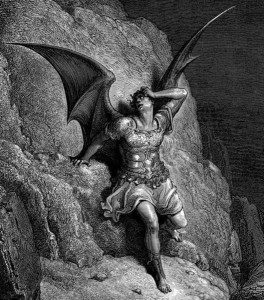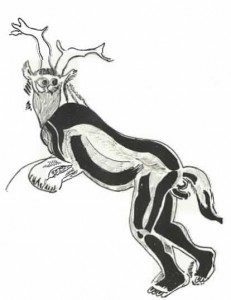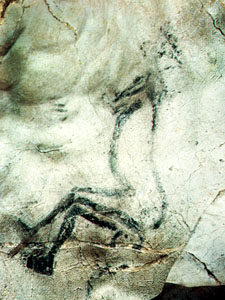“An apology for the devil: it must be remembered that we have heard one side of the case. God has written all the books.” – Samuel Butler
 What really do we know about this character, Satan, whether by another name or face?
What really do we know about this character, Satan, whether by another name or face?
A red skinned imp, sporting short stubby horns and spaded tail, and carrying the trident of Poseidon; a mighty demon, winged and menacing, wreathed in fire and who, with the power of the Almighty, casts his will upon the earth and below.
Some say he’s a figment of our imagination, or is that, as Charles Baudelaire (1821-1867) mused, the punch line of his finest trick?
Lucifer, Beelzebub, Bael, whatever name he may be known by, he remains the embodiment of sin, evil, pain and malice; he is the fallen angel and reigning King of Hell.
But isn’t all of this just dogmatic semantics? Isn’t it just watering down the real issue? When we mention his name or acknowledge his influence, are we paying homage to an antiquated idea of damnation, or are we in fact, referring to a known entity, with a real history and a legacy that will live on well past the last breath of man?
Though many learned men and women believe they know the answer to these questions, as they recite chapter and verse, and regurgitate passed down seminal teachings and warnings of damnation and sin, what really do we know?
As is the mantra of the creationist view of history, the earth is said to be only 6000 years old (give or take a decade), and in the apologist view of Christianity, the Devil is just as real as their One True God. Theisticaly speaking, regardless of one’s personal belief as it relates to creationism or Christianity, one must acknowledge the fact that, without exception, every religion on earth, now and in the past, has had some incarnation of Satan in its teachings or lore.
Though, as many of my fellow atheists would hastily point out, mass belief in an idea, does not make proof of the idea’s merit or existence. And in the same breath I must acknowledge that the absence of evidence is not evidence of absence (as much as I loath to provide ammunition for the apologist agenda).
Where is all this going you ask? (Yes, I know you’re asking.)
Some 15,000 years ago in a remote cave, known to palaeontologists as Lascaux, one of the three brothers, or Les Tres Frere (a grouping of deep Palaeolithic caves located in what is now southern France, specifically in Montesquieu-Avantès, in the Ariège département) an ancient artist rendered what may be the first depiction of the character known to us as Satan.
Before I explain myself, let’s let that sink in a minute. 15,000 years ago, somewhere around 13,000BC, well more than twice as old as any Creationist theology can account for, and yet, as some claim, there exists a clear depiction of the Devil in the form of a charcoal drawing with etched detail; part man, part beast, hoofed feet and a horned crown of antlers.
Discovered in 1914, the cave contains over 280 drawings and engravings, and deep in an interior chamber called the “Sanctuary”, protected from the elements and preserved for posterity for many an era, is this posthumous illustration of what scholars regarded as the earliest known depiction of any deity in any form.
Some of you are already picking apart my dialogue, some of you picked up on that subtle hint of uncertainty, and I promise I’ll get to that, but first, let’s explore what the discovery of this Devil Drawing means.
A detailed drawing of Satan, carved into the wall of a cave 15,000 years ago, 13,000 years before the birth of Christ, and nearly 7,000 years before the so-called creation of the universe. The artist known only by the epic scale of his life’s work, saw fit to devote more than 15 feet of granite, in the deepest, darkest and most protected part of the entire cave network, to the masterpiece of his fresco; a hunched, grotesque and oddly familiar figure.

Henri Breuil, a turn of the century Renaissance man, archaeologist, anthropologist, ethnologist and geologist, endeavoured to reproduce the cave drawing on canvas. His drawing, known as “the Sorcerer” was regarded as solid evidence of early man’s awareness of deity relationships, and with that assumption came wild assertions that the artist was indeed paying homage to the Devil, and/or providing warning to those who would come after.
Breuil initially regarded the cave drawing as a depiction of a shaman or magic man, and later adopted the deity explanation at the behest of Margaret Murray, a prominent British anthropologist; though Murray’s motives were less than academic, in at least this one instance.
Recent studies of both the cave drawing and of Breuil’ sketch have cast doubt on that original assessment, and as promised, we’ll get to that in a moment.
It should first be noted that Murray, once famed for her academic mastery in archaeological study, eventually became an aggressive proponent for the early horned man neo-pagan religious trends of the early 20th century, a movement which eventually evolved into what is now known as Wicca.
One can surmise that either Murray was struck with spiritual inspiration through her study of “the Sorcerer”, or, that her own growing religious predilections at the time of Breuil’s sketch, were her motivation for convincing Breuil to abandon his initial assessment, in favour of her deity explanation, thus adding to her own professional credibility at the time.
This leads us back onto the path of reason and logical evaluation. What lies inscribed on the wall of the “Sanctuary”, deep in the bowels of Lasceux, is a Palaeolithic depiction of a tribal shaman. Features of the drawing are easily, or at least relatively easily, explained as part of communally important ritualistic practises of a wizened and mystical shaman. This character would have been critically important to its tribe and thus regarded with higher status than typical citizenry.
The man-beast depiction is likely a literal telling of the typical connection between shamanism and animal spirits. Even today, shamanism widely makes use of animal skins, horns and animal behaviours in ritual and in practice. This may have been an early, if not the first, example of spiritual worship, but it was certainly not worship of the Devil, or of a God for that matter.
So what does that mean for the ideas that brought us this far?
Think about that for a moment…for some of you at least, my earlier remarks were enough to send your idea’s of religion, God and the Devil into a spinning confusion (ok, maybe I’m kidding myself), and whether or not you were following me into that dark corner, anyone can see how a convincing story backed up by minimal facts can be taken too far, and ultimately adopted as gospel.

What if there was this type of evolution in the deities we currently know as God and Satan? The horned man idea has been prevalent in most neo-pagan religious teachings since before Margaret Murray, though she certainly helped the cause along; and since her time, the stories, legends and rumours of the horned man have evolved, many believe that the Wiccan deity Green Man is a variation of the horned man archetype. And even as I lay that idea before you, many of you are accepting the idea that pagan cultures have adapted their beliefs over time, but isn’t the same true for the monotheistic religions as well?
Isn’t it possible that our current idea of Lucifer is actually an amalgamation of many, many different folk lore depictions of similar shamanistic rituals? Apologists and Creationists (if there is any separation between them), will loudly oppose that idea, but if we understand the corruptions of pagan and neo-pagan ideals that took place over the last 1000 years of Christianisation, can we not see how ancient ritual lore could have been adopted, perverted and distorted into the epitome of evil in our culture?
In the end, I’m not sure I even understand where I was headed with this, except that I hope to call for people to begin opening their eyes; opening their minds and realising that some of the proverbial sketches they may be shown, could in fact be misinterpreted cave drawings in the hands of those with religious agendas.
